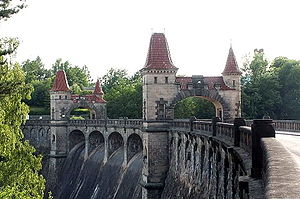The Království dam
The dam Les Království (German: dam Kingdom forest ), also known as dam Těšnovská or dam Bílá Třemešná , is a flood protection and energy generation dam in neo-Gothic architecture on the upper reaches of the Elbe in the Czech Republic . The dam and its ancillary structures were built between 1910 and 1920 and declared a technical monument in 1964 and a national cultural monument in 2010 .
The dam is located four kilometers upstream from Dvůr Králové nad Labem in the valley of the Elbe through the Kocléřovský hřbet between the villages of Nemojov and Bílá Třemešná in the Kingdom Forest .
investment
The entire facility is in neo-gothic built style and consists of the dam with a motorable road and two gatehouses , which are located above the water inlets, the dam keeper's house with a donjon designed tower on the right bank and another smaller tower on the left bank of the Elbe and a generator house at the foot of the dam. The two gateways each have two decorative turrets, a small one with a pointed conical roof over the water inlet and a large one with a pointed hipped roof . The towers on the right and left banks are crowned with battlements .
history
As a result of the flood of the Elbe in July 1897, plans were drawn up to build flood protection systems between the Giant Mountains and Pardubice . In addition to Krausebauden in the Giant Mountains, Weiß Tremeschna in the Kingdom Forest was planned as the location for two dams, where a water volume of 550 m³ per second had rolled through the narrow Elbe valley during the flood of the century and caused severe flooding in the East Bohemian plain.
In addition to flood protection, the system should also serve to generate electrical energy and as a water reservoir for dry periods. In 1903 the engineer Josef Plicka began planning a dam at Weiß Tremeschna / Přehrada Bílá Třemešná . Construction began in 1910 by the Prague company Volflík and a year later the Reidlich & Berger company began building the Krausebauden dam / Labská přehrada. The Teschnen / Těšnov wood grinding shop belonging to the Elbemühl paper mill and publishing company was flooded with the dam .
The outbreak of the First World War in 1914 interrupted work on the project, which cost 4.7 million Austrian crowns . After the collapse of the Austro-Hungarian monarchy , the newly founded Czechoslovakia resumed work in 1919, and in 1920 the construction of the then largest dam in Czechoslovakia was completed. The machinery of the hydroelectric power plant, which was started in 1920 and connected to the grid in 1923, has an output of 2 × 600 kilowatts and comes from the Prague company Fanta & Jireš.
The 218 m long and 41.1 m high dam is a gravity dam made of Königinhofer sandstone, which is 37 m wide at the base of the dam and 7.2 m at the top of the dam. The local connecting road from Bílá Třemešná to Podháj leads over the top of the dam. The water depth at the dam is 28 m. The dam dams the Elbe over a length of 5.1 kilometers and has a maximum water surface of 85 ha. At normal water level, the reservoir has an area of 58.6 ha. The usual storage volume is 996,500 m³, with a maximum capacity of 9,158,600 m³ of water.
Web links
- The Království dam on krkonose.eu
- http://bimbo.fjfi.cvut.cz/~horsky/prehrady/leskr/uv.html
- http://www.ivo-turista.kvalitne.cz/leskralovstvi.htm (Czech)
Coordinates: 50 ° 27 ′ 30 ″ N , 15 ° 45 ′ 50 ″ E







